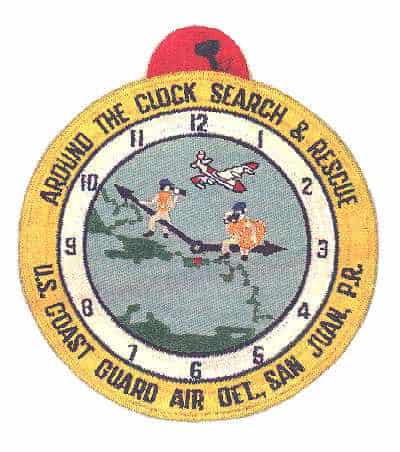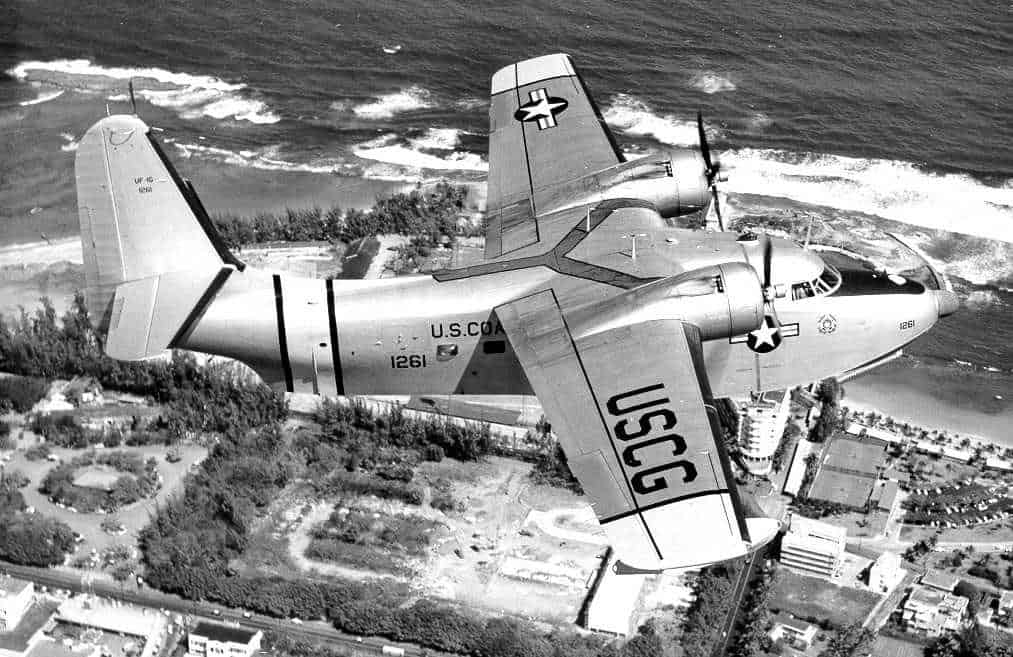 Puerto Rico and adjacent Caribbean Islands were in the Tenth Naval District and part of the Caribbean Sea Frontier and for short time after World War II there was a Tenth Coast Guard District. An air detachment consisting of Chief Aviation Pilot Fred Guild, a radioman, a mechanic and one JRF Goose was established to provide transportation and services for the District Commander, Commodore Barton. The post war duties and responsibilities of the Coast Guard were being determined. The area from the Haiti – Dominican Republic border eastward including the islands within the area of maritime responsibility became the Antilles Section, with Headquarters in Puerto Rico, and became part of the Seventh Coast Guard District.
Puerto Rico and adjacent Caribbean Islands were in the Tenth Naval District and part of the Caribbean Sea Frontier and for short time after World War II there was a Tenth Coast Guard District. An air detachment consisting of Chief Aviation Pilot Fred Guild, a radioman, a mechanic and one JRF Goose was established to provide transportation and services for the District Commander, Commodore Barton. The post war duties and responsibilities of the Coast Guard were being determined. The area from the Haiti – Dominican Republic border eastward including the islands within the area of maritime responsibility became the Antilles Section, with Headquarters in Puerto Rico, and became part of the Seventh Coast Guard District.
In April of 1950 a Coast Guard Search and Rescue air detachment, CDR Ray Blouin commanding, was established at the Naval Air Station on Isla Grande at San Juan. The detachment had nine pilots assigned and two PBY-5As replaced the JRF. In July of 1952 two UF-1Gs replaced the PBYs. October of 1952 a JRF was again added and a second JRF was received in February of 1953. SAR was provided within the maritime region and a rescue control center was established at the U.S. Coast Guard Base, San Juan which was adjacent to the Naval Air Station.
The Coast Guard located the air detachment in Puerto Rico to best cover the area where American activity was the greatest. However, the Coast Guard gives succor to all regardless of nationality or location and aircraft were dispatched on rescue missions, when needed, to any place in the Caribbean. SAR cases ranged from the normal medical evacuations and disaster relief to the unusual and unexpected. The unexpected happened on April 11, 1952. Pan American flight 526-A, a DC-4 with 64 passengers, lifted off from the Isla Grande airport bound for New York. Shortly after take-off two of the four engines failed and the Captain informed the control tower that he could not maintain altitude and that he was ditching at a point approximately seven miles north northwest of Isla Grande. The tower notified the rescue center and a PBY was launched and surface vessels got underway. The situation being critical, the second PBY was removed from maintenance status and was also launched. The sea was rough but when the orange signal smoke was sighted one of the PBYs flown by LCDR Ken Bilderback made a landing. Only 17 of the passengers and crew were found and rescued. One of which was a small boy not in a raft. Copilot Jack Natwig went out the hatch of the PBY to rescue him. Seas were worsening and upon the arrival of the Coast Guard buoy tender Bramble, which had medical personnel aboard, all survivors except two teen age boys were transferred. The PBY was now taking on water and LCDR Bilderback, realizing that he would not be able to make a successful take-off, taxied in the sea back to the San Juan Harbor.
By 1956 UF-2G aircraft were aboard and the Coast Guard Air Detachment was also serving as the aviation facility for the Navy Base at Isla Grande. In the early 1960s a C-123 was added for LORAN logistics. The C-123 made bi-weekly flights to Supply the LORAN stations at South Caicos and San Salvador. In addition flights were made to Grand Turk to obtain fuel for the generators at South Caicos. The fuel trailers were easily on-loaded and off-loaded from the C- 123. The supply run was reversed in 1967 and the C-123 was based out of Miami.

With three HU-16s and the desire to provide helicopter coverage for the Puerto-Rico area, Isla Grande had become too small.
In November 1971, the Air Station relocated to its present location at what was then Ramey Air Force Base in Aguadilla, and became known as Coast Guard Air Station Puerto Rico. Two years later the Air Force discontinued its operation at Ramey, turning the facilities over to the Commonwealth of Puerto Rico and the United States Navy. The Coast Guard assumed the host role in July 1976, when the Navy vacated the station. It was then that the unit was designated Coast Guard Air Station Borinquen.
The Air Station originally utilized three HU-16E Albatross seaplanes and two HH-52A Sea Guard helicopters to affect its search and rescue missions. In March of 1973, three HH-3F Pelican helicopters replaced these aircraft. The need for increased range for interdiction law enforcement and search and rescue resulted in the addition of four HU-25A Falcon Jets to the Air Station’s inventory in late 1983 and early 1984. In 1985, four new HH-65A Dolphin short-range rescue helicopters replaced the three HH-3F Pelicans, giving the Air Station a shipboard deployment capability. The HU-25A Falcons were replaced in 1987 by three HC-130 Hercules aircraft that provided long range search and surveillance capability until their departure in June 1996. Due to the increased tempo of operations in the Caribbean, the Air Station again added four HU-25A Falcons to the inventory from July 1999 until September 2001. The Air Station currently operates with HH-65 Dolphin helicopters while also supporting a variety of forward deployed aircraft.

